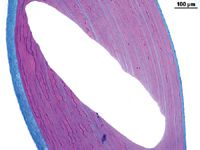- COVID-19
- Biosimilars
- Cataract Therapeutics
- DME
- Gene Therapy
- Workplace
- Ptosis
- Optic Relief
- Imaging
- Geographic Atrophy
- AMD
- Presbyopia
- Ocular Surface Disease
- Practice Management
- Pediatrics
- Surgery
- Therapeutics
- Optometry
- Retina
- Cataract
- Pharmacy
- IOL
- Dry Eye
- Understanding Antibiotic Resistance
- Refractive
- Cornea
- Glaucoma
- OCT
- Ocular Allergy
- Clinical Diagnosis
- Technology
FDA Oks new inidication for iFS femtosecond laser
On April 20, Abbott Medical Optics announced that it had received FDA clearance for use of the 150-kHz iFS advanced femtosecond laser to create arcuate incisions during corneal surgery, including cataract surgery.
On April 20, Abbott Medical Optics (AMO) announced that it had received FDA clearance for use of the 150-kHz iFS Advanced Femtosecond Laser to create arcuate incisions during corneal surgery, including cataract surgery.

"The advantage of making arcuate incisions using the femtosecond laser instead of manually with a blade is that the laser is extremely precise and repeatable," said Roger F. Steinert, MD, chairman, Department of Ophthalmology, and director, Gavin Herbert Eye Institute, University of California, Irvine. "With the laser we can essentially eliminate the variability in incision depth, shape, size, and location that plagues us when making arcuate incisions manually with a diamond blade."



Studies support versatility, predictability
Performing arcuate incisions with the iFS requires no software purchase if users have software v2.20 or higher. The laser can be used to make penetrating or intrastromal arcuate incisions with customization of length, depth, and optical zone.
Perry S. Binder, MD, clinical professor of ophthalmology, Gavin Herbert Eye Institute, conducted laboratory studies at AMO to evaluate the performance of the iFS in creating intrastromal and penetrating arcuate incisions. The data supported the 510(k) approval of the iFS for creating arcuate incisions, and the research was presented at the 2012 ASCRS Symposium in Chicago and the 2012 ARVO meeting in Fort Lauderdale, FL.
Findings from a study using human cadaver eyes established that the laser made the intrastromal incisions accurately in terms of planned distance from the epithelium and Descemet's membrane, and demonstrated the feasibility of predictably varying arc length, optical zone diameter, and side cut angle. Results from an in vivo study in rabbits showed penetrating arcuate incisions made with the femtosecond laser healed faster than those made with a diamond blade.
"The accuracy in the depth of the incisions made with the laser allows for greater safety by reducing the risk of posterior penetration compared with the manual, diamond blade technique, and because fewer stromal lamellae are incised by the intrastromal laser cut, the refractive effect achieved with the laser procedure should be more stable even if it is less in terms of diopters of correction compared [with] incisions that penetrate the epithelium and Bowman's layer," Dr. Binder told Ophthalmology Times.
"Using the iFS, surgeons also have the flexibility to vary incision features precisely, although further study is needed to establish appropriate nomograms for side cut angles, arc length, and optical zone diameter settings," he said.
